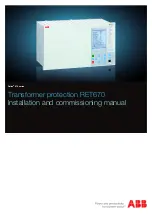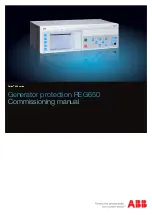
•
Internal and configurable pickup and dropout delay
•
Modifiable message texts.
Synchrocheck (only 7SJ623, 7SJ624, 7SJ625, 7SJ626 and 7SJ64)
•
Verification of the synchronous conditions before reclosing after three-pole tripping
•
Fast measurement of the voltage difference ΔV, the phase angle difference Δ
ϕ
and the frequency differ-
ence Δf
•
Alternatively, check of the de-energized state before reclosing
•
Switching possible for asynchronous system conditions with prediction of the synchronization time (only
7SJ64)
•
Setable minimum and maximum voltage
•
Verification of the synchronous conditions or de-energized state also possible before the manual closing
of the circuit breaker, with separate limit values
•
Measurement also possible via transformer without external intermediate matching transformer
•
Measuring voltages optionally phase–to–phase or phase–to–ground.
RTD box
•
Detection of any ambient temperatures or coolant temperatures by means of an external RTD box and
external temperature sensors.
Phase Rotation
•
Selectable ABC or ACB by setting (static) or binary input (dynamic).
Circuit-Breaker Maintenance
•
Statistical methods to help adjust maintenance intervals for CB contacts according to their actual wear
•
several independent subfunctions have been implemented(Σ
Ι
-procedure, Σ
Ι
x
-procedure, 2P-procedure
and
Ι
2
t-procedure)
•
Acquisition and conditioning of measured values for all subfunctions operates phase-selective using one
procedure-specific threshold per subfunction.
User Defined Functions
•
Freely programmable linking of internal and external signals in order to implement user-defined logic
functions
•
All standard logic functions (AND, OR, NOT, EXCLUSIVE-OR, etc.)
•
Time delays and limit value interrogations
•
Processing of measured values, including zero suppression, adding a knee curve for a transducer input,
and live-zero monitoring.
Breaker Control
•
Circuit breakers can be opened and closed via specific process control keys (models with graphic displays
only), the programmable function keys on the front panel, via the system interface (e.g. by SICAM or
SCADA), or via the front PC interface using a personal computer with DIGSI)
•
Feedback of switching states via the switch auxiliary contacts
•
Plausibility monitoring of the circuit breaker position and check of interlocking conditions.
Introduction
1.3 Characteristics
SIPROTEC 4, 7SJ62/64, Manual
29
C53000-G1140-C207-8, Edition 08.2016
Содержание SIPROTEC 4
Страница 8: ...8 SIPROTEC 4 7SJ62 64 Manual C53000 G1140 C207 8 Edition 08 2016 ...
Страница 18: ...18 SIPROTEC 4 7SJ62 64 Manual C53000 G1140 C207 8 Edition 08 2016 ...
Страница 30: ...30 SIPROTEC 4 7SJ62 64 Manual C53000 G1140 C207 8 Edition 08 2016 ...
Страница 540: ...540 SIPROTEC 4 7SJ62 64 Manual C53000 G1140 C207 8 Edition 08 2016 ...
Страница 594: ...594 SIPROTEC 4 7SJ62 64 Manual C53000 G1140 C207 8 Edition 08 2016 ...
Страница 720: ...720 SIPROTEC 4 7SJ62 64 Manual C53000 G1140 C207 8 Edition 08 2016 ...
















































